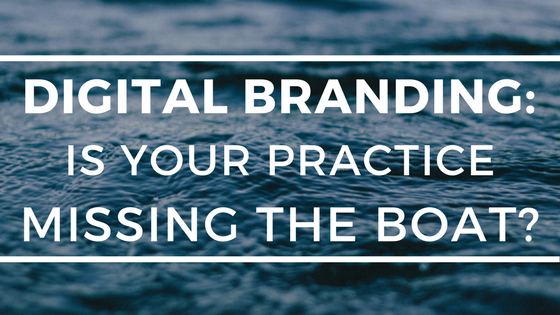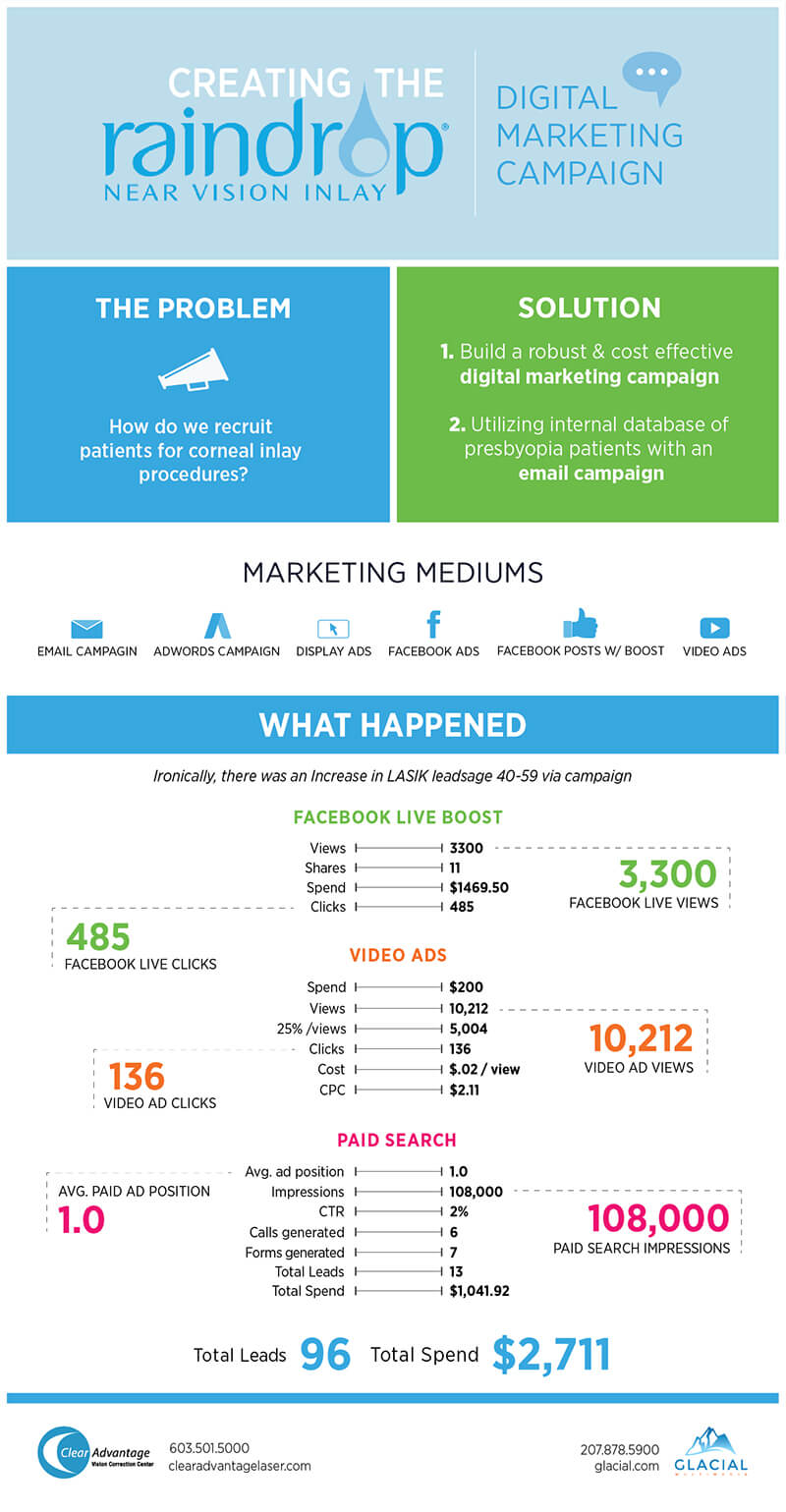Posted on April 5, 2017
Is Your Practice Missing the Boat with Digital Branding?

Coming off the 2017 Vision Expo Meeting in New York City has been exhilarating and motivating. The Optometry community never ceases to amaze me with their innovative capabilities and uniqueness to create new opportunities. I wanted to review some of the new advertising elements that both optometry practices and medical clinics have deployed this year.
2017 has been a great year of implementation of innovation in digital branding but many practices are missing the boat. The most compelling aspect of digital branding activities is the ease of deployment and the actual cost of media. Not only are certain digital branding projects relatively simple to deploy but the media costs are really affordable. This is why I tend to look at these activities as “branding”. The reason is simple. The costs are so low that there is really no need to track ROI because it’s worth it just to create “top of mind” awareness.
Digital branding has been emerging over the past five years as a term that most likely came from direct marketing. Initially, the first levels of Internet marketing were triggered by intention-based search, primarily around the areas of SEO and paid search. The digital branding modalities of today are differentiated by the fact that they are a type of digital marketing with less involved intent, hence the term “branding.” Combining with the increased demand to serve to multiple devices, primarily mobile, created new ways of communicating and interacting.
Because some of these concepts are new to medical marketing, I thought I would highlight some of the best options. Although digital branding may include SEO, paid search, and local search, I am going to focus on more of the lower cost aspects and unknown modalities.
FACEBOOK ADS
Facebook ads are important to brands because of the extra reach, exposure, and targeting options available to brands. Facebook’s detailed targeting tools allow you to get as narrow or as broadly focused as needed. Facebook ads continue to be one of the most cost effective ways to target potential patients. The engagement we have tracked so far is very impressive. I would suggest a geo-targeted and interest targeted campaign promoting your overall brand and preferred procedures.
According to research compiled by HubSpot, Facebook Ad revenue grew from just under $2 billion in 2010 to $12.5 billion, with ads on the popular social platform accounting for more than 9% of total digital ad spending and 18.4% of global mobile digital advertising.
GOOGLE DISPLAY ADS
The Google display network can show varying sized image ads across the web. They could be seen on a local media site, national weather site or even travel sites. This is another technique used for creating brand awareness. Take some time and make something “eye catching.” It’s a more passive form of advertising, whereas the Search Network is more active. In other words, people are actively looking for something when they come across Search Network ads, whereas they are often casually browsing websites when they happen upon the Google Display Network. This network enables you to target audiences in different ways including by keywords, retargeting and placed ads.
YOUTUBE VIDEO ADS (PRE-ROLL)
These video ads can produce gigantic results and tons of views, which I feel is great for branding. I very rarely see eye care practices or medical clinics using this medium and it’s unfortunate because it’s highly effective and targeted. By using the Google Adwords platform, you can place your video ad just prior to a video someone is trying to watch. This can actually be geo-targeted in the same way that your click campaign would work. If you have ever watched a YouTube video, there is a high probability that you have seen what I am talking about. We recently did an ad campaign to promote the new presbyopia vision correction device called the Raindrop® Near Vision Inlay. In a one- month period we had over 10,000 views for a cost of only $200.

FACEBOOK LIVE
Facebook Live is not just a buzzword or a fad. It has proven to be a highly effective method of generating excitement and interest in your practice. If you are a practice that has done this, you know what I am talking about. This aspect of digital branding might be a little more difficult for practices. Facebook Live posts will need to be conducted internally by a socially savvy employee and not through an agency. There are many people to consult about how to get started with Facebook Live. I have had practices do this for a wide variety of procedures including LASIK and Raindrop®. In the recent Raindrop® digital marketing campaign we experienced over 3,300 views for a cost of around $1450. The costs mostly come from extra boosting that was done in the campaign after video launch.
GEOFENCING
This new topic targets mobile devices at different locations. The ads can also continue to target people sometime after the visitor has left a specific location. Geofencing shopping malls, chains and outside activities has been popular in the work our group has done.
With geofencing there are two main methods. One is where your phone is targeted by an app that has been installed and the other is non-app based geofencing. For the sake of practice marketing the pertinent type here is non-app based geofencing. Since most patients have no reason to download their doctor’s app, we have focused on this type. With this type of geofencing and geo-aware campaign, we can reach a wider audience by utilizing location features and trigger an ad. With this type of geofencing, you will need a DSP (Demand Side Platform) to do the media placement.
RETARGETING
Retargeting is one of the oldest types of digital branding discussed in this article and many of you have probably heard about this. With remarketing or retargeting, various sized ads can be served to visitors who made it to your website or associated landing page. We have had excellent branding success using retargeting and have seen this to provide a provide impact on overall awareness.
INFOGRAPHIC CREATION AND DISTRIBUTION
When doing digital branding it makes sense to create an asset base. Although this article will not detail all the types of assets that can be used, we did want to point out the relevance of infographics. If you need more ideas on infographics, Pinterest does a wonderful job of collecting and distributing information this way. These types of graphics can be easily shared and can often be accompanied by an embed code. According to Search Engine Journal, 90% of the information that we remember is based on visual impact. Use the power of infographics to make better sticky points relative to your value proposition.
CUSTOM RESPONSIVE LANDING PAGES
Additionally, we have perhaps the most important asset of all. The unique landing page. By creating specific and unique landing pages you can better engage and capture leads. By using the A/B or A/B/C approach to landing page deployment, your campaign can really get detailed with lead tracking analysis. This way, you can determine which digital media platform created what type of return on investment. This is critical to expanding budgets in each one of these digital branding zones.
CONCLUDING REMARKS
Digital branding will have significant impact on media budgets in 2017 as more people move away from TV, radio and print advertising. You simply get a better bang for your buck. This is not to say that there is not a place for a marketing mix but today’s marketers will surefire find ways to detail lead tracking and return on investment. By having a compelling story mixed with good asset creation and focused messaging, your practice can get that marketing edge at a lower cost!
